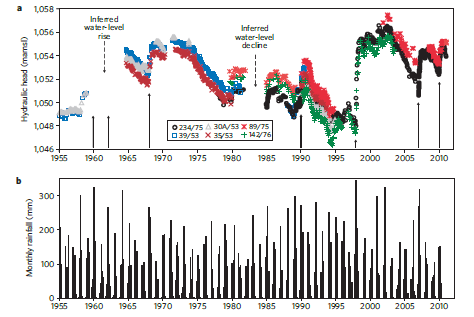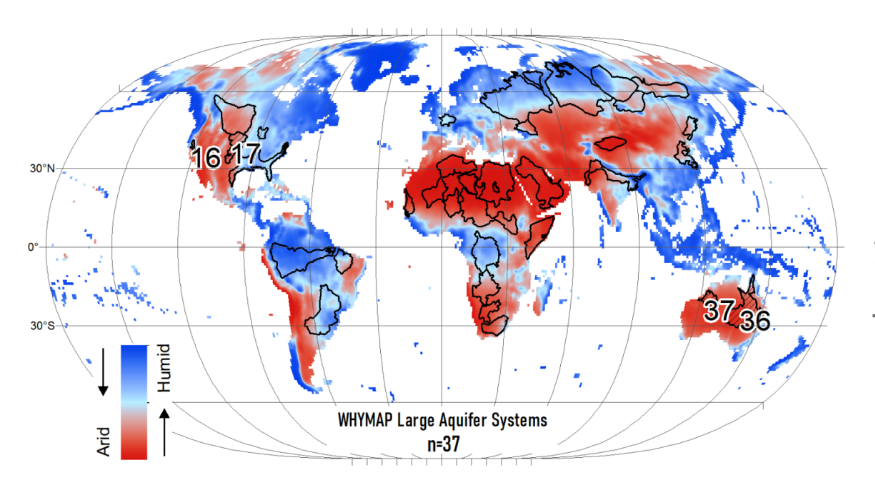Listen here on Spotify | Listen here on Apple Podcast
Episode recorded May 11, 2023
Episode released on June 29, 2023

Richard Taylor is Professor of Hydrogeology in the Department of Geography at University College London. His research focuses on climate impacts on groundwater resources and developing resilient, equitable and sustainable groundwater resources in tropical Africa and South Asia.
Highlights | Transcript
- Extreme heavy rainfall increases groundwater recharge as shown by groundwater level rises in wells that can interrupt a succession of dry years, as observed recently in the Horn of Africa.
- Climate extremes across tropical Africa often demonstrate associations with large-scale controls on climate variability including ENSO and Indian Ocean Dipole (Cuthbert, Taylor et al., 2019)
- ENSO dipole impact between Eastern and Southern Africa (Kolusu et al., 2019):
- El Niño: wet East Africa, dry Southern Africa
- La Niña: opposite: dry East Africa, wet Southern Africa
- Positive Indian Ocean Dipole (IOD): increased rainfall in Eastern Africa and Southern Africa (SON) - example: Makutapora (25 km N of Dodoma, capital of Tanzania) groundwater level hydrograph shows 520 mm recharge from rain in 1997-1998 (Fig. 1) associated with strongest El Nino event on record (1997-1998) and positive IOD (Taylor et al., 2013).
- High recharge associated with heavy rains is supported by groundwater level monitoring but also stable-isotope ratios of O and H wherein heavier rainfall is depleted in heavy isotopes (The Amount Effect), consistent with higher levels of light isotopes found in groundwater across the tropics (e.g. Jasechko and Taylor, 2015; Cissé Faye et al., 2019; Goni et al., 2021).
- Fewer but heavier rainfall associated with global warming should increase groundwater recharge and storage in the tropics (Mileham et al., 2009; Owor et al., 2009; Cuthbert, Taylor et al., 2019).
- Need to understand groundwater systems to manage them reliably: e.g., Makutapora wellfield is sourced from excess water from the upland areas 30 to 50 km away and not the immediate vicinity of the wellfield (Seddon et al., 2021).
- We normally think heavy rains would run off and not recharge the aquifers because of high intensity. But these heavy rains can recharge the aquifers because of large pore spaces (macropores) and preferential pathways in the soils and underlying vadose zone allowing recharge during heavy rains (Taylor et al., 2004; Owor et al., 2009; Kotchoni et al., 2019).
- Preferential flow results in groundwater being more vulnerable to contamination (e.g., E. coli, etc) from heavy rains and rapid recharge (Taylor et al., 2010; Sorensen et al., 2021; Pouye et al., 2023).
- GRACE satellite data are also consistent with increases in groundwater storage in response to heavy rainfall events in drylands, Fig. 2 (Shamsudduha and Taylor, 2020).
- Land use change also affects groundwater storage and was responsible for The Sahelian Paradox: under low rainfall conditions, groundwater levels were rising in Niger and surrounding regions because land use changed from native shrubs and grasslands to croplands with shallow roots and fallow periods (Favreau et al., 2009).
- Global modelers are starting to incorporate process understanding from your field studies (e.g. focused recharge) into their models, such as WaterGAP (Müller-Schmied et al., 2021).
- Global Climate Models projecting increased precipitation in East Africa with climate change but we are actually seeing declines in the long rains (March, April, May) in the Horn of Africa, termed The East African Paradox (Wainwright et al., 2019).
- Primary funding sources for your research: UK Research and Innovation, The Royal Society, and Foreign and Commonwealth Development Office (FCDO), formerly DFID; and International Development Research Centre (IDRC, Canada).
- UPGRO (Unlocking the Potential of Groundwater for the poor) included five consortia (GroFutures - Groundwater Futures in Sub-Saharan Africa; Hidden Crisis)
- Big emphasis on capacity development and knowledge co-production (e.g. Cuthbert, Taylor et al., 2019) with research in country led by research institutions in tropical Africa (e.g. Addis Ababa University, Ethiopia; Sokoine University of Agriculture, Tanzania; Université Abdou Moumouni, Niger; University of Maiduguri, Nigeria)
Working with stakeholders in Ethiopia, Kenya, Tanzania: interested in low intensity development of groundwater that is more equitable and environmentally sustainable.

Figure 1. Groundwater levels and rainfall from central Tanzania. a, Time series of groundwater-level observations from 6 monitoring wells (a), monthly rainfall) at the Makutapora Wellfield from 1955 to 2010. Groundwater level rose ~ 8 m in 1997 – 1998 period corresponding to strongest El Niño on record (Taylor et al., 2019) 
Figure 2. Global map of aquifers where GRACE Total Water Storage time series were evaluated showing interannual variability linked to wet and dry climate cycles (Shamsudduha and Taylor, 2020).



